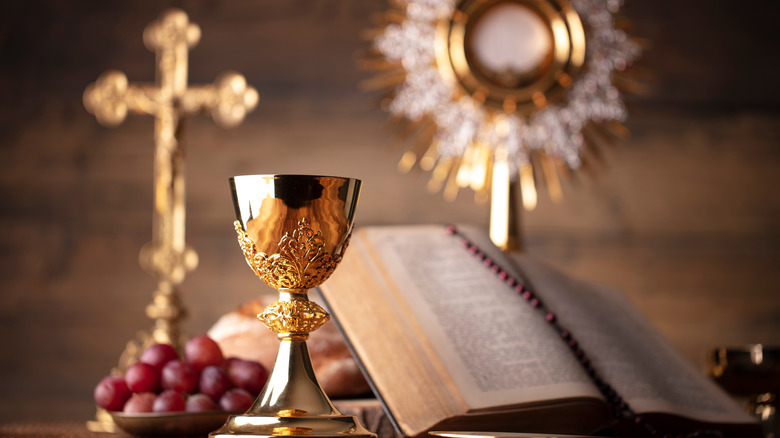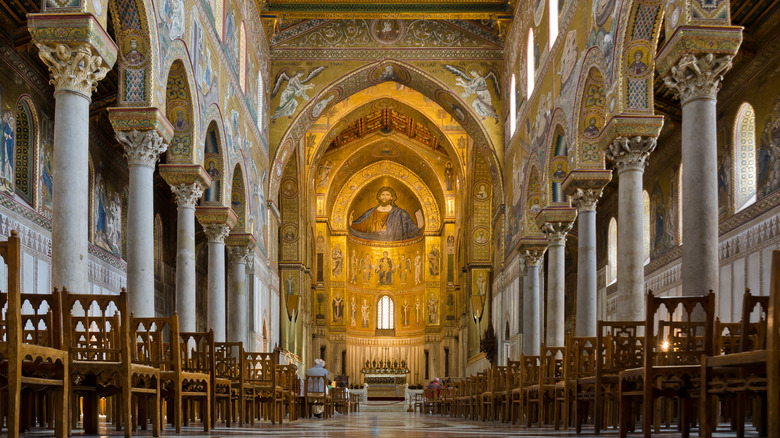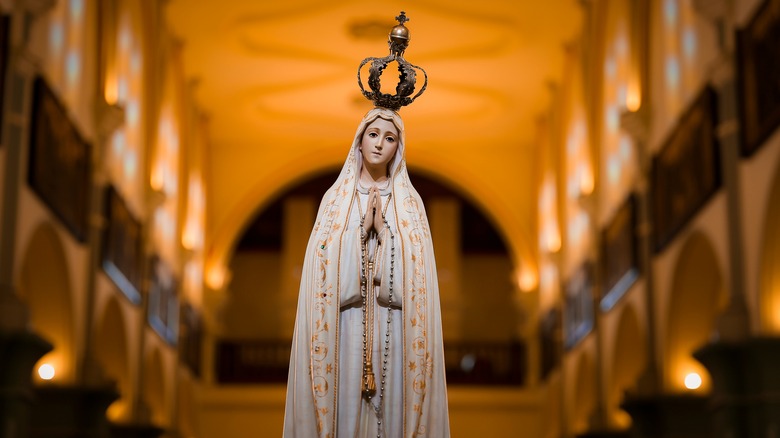The Practice Of Preserving Literal Pieces Of Saints In Catholic Altars
It's generally not okay to store pieces of dead people in the cupboard. But if those dead are the sanctified dead of Catholic ritual, and the pieces aren't so much "in the cupboard" as they are enshrined in an altar, then cool. The medieval Christian world used to be full of relics of the famously holy dead, like Mary Magdalene. Lesser pieces and hot-item fragments alike — shrouds, tongues, fingers, foreskins — used to be peddled, traded, bought, sold, stolen, and heralded on the regular. Nowadays, it might seem unseemly to place an authentic 8th-century C.E. gold-leaf-laden middle finger metacarpal in the cupboard above the microwave with the rest of your collection, but for churches, traditions endure.
Take the Cathedral of St. Peter the Apostle in Kansas City, Missouri, one of the more unlikely places you might think of when envisioning Catholicism and/or impressive and beautiful cathedrals. As The Leaven says and shows, they've got literal hundreds of bits of saints in containers — reliquaries — behind the altar. Bishop Donnelly, creator of the region's archdiocese, wrote to Rome back in the day for some relics, and Rome delivered. Each relic came with a certificate of authenticity written in Latin, such as that belonging to Pope Pius V, who died in 1572. And in case you're wondering, it's not just this one church in this one city and country that's got relics. As UCatholic says, it's apparently all of them — every single one.
Something left behind
We can't take a survey of each and every Catholic diocese, parish, church, and chapel in the world, but sources like UCatholic state that all of them contain relics. While we don't often see new churches being built, it stands to reason that the Vatican has some relics on standby to distribute as necessary.
That being said, Catholic Answers lives up to its name by answering a crucial question for the skeptical: the church has never officially endorsed a relic as genuine (despite apparent certificates of authenticity, as The Leaven describes). Theological particulars about the Intercession of the Saints notwithstanding, it's at least true that the church recognizes the meaning that relics have for people, like holding onto a keepsake. This is probably a good perspective to adopt, because even in the modern day, supposed relics keep cropping up. Live Science, for instance, describes archaeologists in Turkey in 2013 claiming to have found a piece of Jesus' cross in a stone chest in the basement of the 7th-century Balatlar Church in Sinop along the coast of the Black Sea.
UCatholic tells us that the practice of literally holding on to the pieces of the dead started with the Second Council of Nicaea in 787 C.E. The goal of the meeting was to unite the church and unify its still-developing doctrine, as Papal Encyclicals Online states. The council decided that — perhaps for the sake of continuity with Christian forbears — each church ought to have an "installation of relics."
Rescuing a relic
As for the relics themselves — relic being a word derived from the Latin "relinquere," meaning "to leave behind, forsake, abandon, give up" — Scripture Catholic tells us they come in tiers. We've got first class, second class, and third class relics. First class relics are pieces of actual people, including bone, hair, etc. Second class relics are things that such people owned, like clothing, books, and so on. Third class relics are things that came in contact with first and second class relics or their owners. Given such breadth, maybe the Vatican really does have a giant depository of relics kept in safekeeping and/or waiting to be distributed to churches.
The Leaven goes on to tell us that buying and selling relics is illegal, which is understandable. But Catholics (no mention of non-Catholics) are allowed to "rescue a relic" if it crops up in a yard sale or something. That being said, it might not be the smartest strategy to go around believing that every tooth and segment of skin hanging around a yard sale belongs to a saint. There are of course just as many fraudsters, hucksters, and snake-oil salesmen prowling the land as there were back in ancient antiquity. Father Anthony Saiki from the aforementioned Cathedral of St. Peter the Apostle in Kansas City, Missouri describes cases of well-meaning people getting duped with supposed — but ultimately forged — certificates of authenticity. Best leave the assessment of saints to the Vatican.


